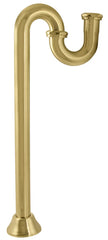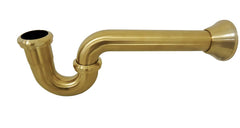Get PRO Pricing
Get [PRO] Pricing

Feature photo courtesy of @scenes_on_summercrest
Most people don’t spend much time thinking about the plumbing under their sinks, tubs, and showers. However, the curving pipe connecting the basin to the drain pipe — also called the P-trap or S-trap — is an essential part of the setup. Understanding how the P-trap works and how to replace one that’s worn out is useful knowledge for any homeowner.

A P-trap is a pipe that runs under a sink, shower, or bathtub and serves a very important purpose in the kitchen or bathroom’s plumbing system. The curved design holds water to create an airtight seal in the pipe. This prevents bacteria, debris, and gases from backing up into the sink or tub. It also traps the occasional hair, food, or small object, such as an earring.
P-traps have been around for centuries, ever since people figured out they prevent clogs and make the room smell better. They come in multiple materials, including polypropylene, ABS, PVC, and brass.
Photo courtesy of @merrillconstruction

Homes built in the early 20th century may have an S-trap under the sink. Named for its distinctive S-shaped curve, the S-trap serves the same purpose as the P-trap. However, the design also makes it more likely to siphon away too much water, leaving behind a dry trap. Without the water creating the seal, unwanted and potentially dangerous gases can enter the home.
The design of the P-trap is an improvement over the S-trap and helps keep water in the trap — and its seal in place. It is possible for a P-trap to go dry, but it’s much less likely than with an S-trap. Today, S-traps do not meet building codes, and although some are still in use in older homes, they are illegal in new constructions

Replacing a P-trap is an easy DIY job for a homeowner. In many cases, they can remove the parts by hand, but a pair of water pump pliers (also called V-jaw tongue-and-groove pliers) can come in handy if the nut holding the P-trap in place is hard to turn. Here’s how.
After replacing the P-trap, it’s time to check the connection and make sure it’s not leaking. Turn on the water and let it run for a few seconds, long enough to check the pipe itself for a leak. If the pipe fits securely, fill the sink with a couple of inches of water. Then unplug the sink, so all the water drains at once, and examine the pipe for signs of a leak. Filling the sink and releasing it adds extra pressure to the pipe and its fittings.

Homeowners who still have an S-trap under the sink should consider replacing it, but they don’t have to wait until there’s a plumbing problem to replace the pipes under the sink or tub. A P-trap is a functional piece that also adds to the décor of the room. It creates an interesting focal point in a room with a vintage or industrial design and under a wall-mounted sink. Try the following tips for showcasing a P-trap in the bathroom.
Photo courtesy of @charestvalentine

In many bathrooms, a cabinet hides the plumbing under the sink. Consider removing the cabinet and replacing it with an open vanity. Not only does this show off the P-trap, but it also opens up the space, making it feel airier while still providing room to store the room’s essentials. Open vanities come in several colors and styles that blend with a variety of design styles.
Photo courtesy of @deannadewaldhome

Choosing a P-trap finish that matches the rest of the fixtures in the room creates a uniform look in the room. For example, if the faucets and handles are polished chrome, choose a P-trap with the same bright, shiny finish. Or, go for a bold look with contrasting finishes — think polished brass with oil-rubbed bronze.
Matching colors is an easy way to achieve a coordinated look, but contrasting colors can add interest to the space. Just be sure to match the undertones, so they don’t clash with the fixtures and the wall color. Cool fixture shades include chrome and nickel, while brass and oil-rubbed bronze have warm undertones. Matte black can mix well with both cool and warm undertones.
Photo courtesy of @brandihinesevents

Using a plumbing kit is an easy way to replace the P-trap. These kits include everything you need to switch out the drain system, like the P-trap, angle stops, and lavatory supply lines. They come in a variety of finishes, which makes it easy to coordinate with the rest of the fixtures in the room. Choose a kit that matches the finish, color, and style of the other fixtures in the bathroom.
Replacing the P-trap is just the beginning of a bathroom makeover. Whether you’re ready to renovate the bathroom or want to give the room a quick refresh, check out the selection of P-traps and other bathroom fixtures at Kingston Brass. You’ll find fixtures in a wide range of styles, from ornate vintage designs to sleek and modern shapes.
